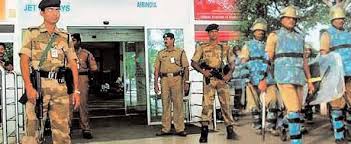
Before India became independent, the maintenance of internal security was an important task of the army. The British rulers laid more emphasis on maintaining internal security than tackling external aggression to further their own survival. During that period, there was no distinction between using the army for internal and external security interests.
After independence, the army was entrusted with the exclusive task of defending the country from external threats. With the delegation of this exclusive task for the army, the strength of the state police forces, central police forces and paramilitary forces was greatly enhanced with a view to relieve the army from frequent assistance to the civil power.
In spite of these developments, over the past 30 years, there has been a deterioration in the internal security scenario with the emergence of ethical or tribal insurgencies in the northeast, Marxist insurgencies in various garbs in different states, periodic communal tension and violent disturbances, extremism having overtones of ideology and religion in various parts of the country, particularly in Jammu and Kashmir, organized crime groups having nexus with terrorists exploitation of the resulting situation by Pakistan and ISI leading to proxy war against India have badly hit the internal security agencies, the state police and central police forces, the Central Industrial Security Force (CISF) and the civilian population.
With our internal security forces working under the constant threat of sophisticated arms, there has been frequent deployment of army and paramilitary forces to tackle the situation and instill a sense of confidence in the civil society. But what is more concerning is the fact that with the scope of violence reaching new heights day by day, the local authorities are coming to rely heavily on the army and paramilitary forces in restoring order apart from engaging them in disaster management, tasks that they were supposed to get relieved from.
As such, the urgent need of the hour, and a serious one, is to develop the political will to undertake express arms modernization of our forces responsible for maintaining internal security. This also assumes urgency in light of the scenario where India stands second lowest among 50 countries ranked (on the basis of police per capita) according to the United Nations Office on Drugs and Crime 2010.The Comptroller and Auditor General of India (CAG), in its 2014 report, criticized Jammu and Kashmir government for providing poor infrastructure and lack of basic facilities for the state police force that needs it most in the county. The CAG report revealed that 18 police stations and 103 police outposts were operating without own buildings and out of 192, only 89 police outposts were functioning from own buildings. Moreover, in eight districts, body protectors and bulletproof jackets were not available with 64 police stations wherein there are 2865 police personnel. When it comes to the capital city, , the Delhi police has been unable to install closed circuit cameras, buy new weapons, vehicles, upgrade technology and build new police stations required for a high-risk city. Police have been given the responsibility to secure an area of 1483 square kilometers and safeguard a population of 1.86 crore with a strength of 77,894 personnel but more than half of them are deployed for VVIP security. Moreover, there are only 13 bomb detection and 4 bomb disposal squads but because of lack of bomb-detection equipment, even these personnel have been diverted to other departments. The bomb squads lacks adequate manpower and infrastructure and personnel with specialized skills.
 Taking a look at the global scenario reveals a rise in police expenditure. According to the Accenture report on ‘Preparing Police Services for the Future’ released in 2014, annual policing expenditure in the United Kingdom currently stands at approx. £ 14 billion, compared to £ 9.8 billion in 1999. The United States spending on police protection has increased by 445 percent since 1982 and it invests more than $ 100 billion on police forces annually.
Taking a look at the global scenario reveals a rise in police expenditure. According to the Accenture report on ‘Preparing Police Services for the Future’ released in 2014, annual policing expenditure in the United Kingdom currently stands at approx. £ 14 billion, compared to £ 9.8 billion in 1999. The United States spending on police protection has increased by 445 percent since 1982 and it invests more than $ 100 billion on police forces annually.
The investment in arms, modern technology and training have shown positive results. Singapore, for their ’Safe City’ pilot program, has integrated advanced analytic capabilities into their existing video monitoring system used in the city by applying computer vision and predictive analytics to video feeds to detect public safety concerns, something that might sound Greek to an Indian police official.
The Central Industrial Security Force, too, needs to be modernized as it has been entrusted with the task of providing security to our key industrial establishments across the country owned by the central government and, now, even the private sector, securing our seaports and airports that remain vulnerable to malafide intrusions and hijackings. It provides security to atomic power plants, space installations, mints, oilfields and refineries, major ports heavy engineering plants, steel plants, barrages, fertilizer units, hydroelectric and thermal power plants partially or wholly run by the government.
The Central Reserve Police Force, one of the largest central police organizations in the world, involved in assisting States and Union Territories’ law enforcement agencies in maintaining law and order and to contain insurgency, deployed as anti-terrorist units in various regions, during elections, in guarding vital installations, in countering naxal operations and with an array of critical duties, it, too deserves arms modernization and up gradation at all levels.
About the Author: Shri Naveen Tewari is a freelance writer for 25 years and writes on topics of social interest with focus on issues of public interest & governance.





Leave a Reply
You must be logged in to post a comment.